Demoscene
I guess I’ll have to give a short introduction to the demoscene for the uninformed reader, right? So here it is: The demoscene is a worldwide (but mostly European) network of creative people who create art with computers. This not only means the obivous stuff like images, music and videos, but also software: So-called »demos« (or the size-limited variants, »intros«) are non-interactive multimedia shows featuring music and state-of-the-art 2D and 3D graphics. If you are familiar with the 3DMark benchmark series, particularly the older, not-so-crippled versions, you already know what a demo is: In addition to the main benchmarking functions, these programs offer a demo with all the scenes from the benchmark section, accompanied by nice music.
My occupation in the demoscene is mainly coding (programming) and a little bit of graphics work. I used to be part of a demo group named Kakiarts and now I’m a member of the group TRBL. Groups like these form a team that works together when more complex demos are developed. But this doesn’t necessarily mean that every member is involved in every released production (or »prod«, the generic term for every demo, intro, image or music track that is produced). On this page, I’ll only mention the releases I’ve done alone or I’ve done a major part for. A complete list wouldn’t be representative either, because I’ve been involved in nearly every Kakiarts demo/intro since 2005 in one way or another and helped with some TRBL demos as well.
Note that the contents of many of the ZIP files that can be downloaded from this page are password-protected. Unfortunately, this is necessary because many virus scanners (and, in extension, even browsers) are under the impression that demoscene 4k and 64k intros must be malware, even though they are perfectly harmless. The password for all ZIP files on this page is »kakiarts« (without the quotes).
Demos and Intros
Arrakis
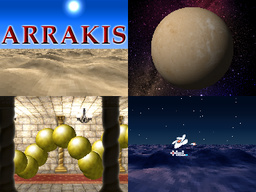
After the huge success of »nano« at Evoke 2006, it seemed to be a good idea to make another iPod nano demo for the next party, tUM 2006. My brother produced the music whose style set the oriental/desert theme. The problem was that we had not much ideas what to show: rain in the desert during the slow break in the soundtrack was one thing, but that’s about it. After only two weeks, the demo has been scrapped with only about 50% of the scenes ready.
Fast forward a decade. In 2016, I decided to go to Nordlicht, which features the unique »gravedigger« compo, where old unfinished demoscene productions can be entered. So I got my hands dirty again and filled these remaining 50% with at least some content, recycling some effects from »nano« and repeating one scene (with slight variations) so that it’s basically stretched over half the demo. Only one scene has been coded from scratch, two days before the party. Nobody seemed to notice though, as the demo was received very well and won the compo.
Awards:
- 1st at Nordlicht 2016 gravedigger competition
Downloads/References:
- arrakis.tgz (3.7M) – the demo, runs on iPod nano (first generation), Linux/x86 and Windows
- discussion at pouët.net (there are also some video links)
Applied Mediocrity
After a very unproductive year and lots of other sceners nagging me with »do you have any releases?« questions at Breakpoint 2009, I was determined to do something for Evoke 2009. Following my tradition, it was going to be a 64k intro, and a meaningless effects show like Vortex 2, except that I wanted do more modern effects this time. I can proudly say that the intro became exactly what I envisioned: There’s no real design or flow, not even a color scheme, but there are eight different scenes with nice shader-heavy effects.
I started coding late, so I hurried up quite a bit and in the end, I was even faster than I thought: I had an almost finished intro when I came to Evoke. The only real problem was the music, because Tristan, our 64k musician, was busy in the USA and couldn’t finish the soundtrack until one night before he became completely unavailable.
Awards:
- 1st at Evoke 2009 PC 64k Intro competition
Downloads/References:
- Kakiarts_-_Applied_Mediocrity_-_Final.zip (60k) – the intro
- discussion at pouët.net
Vortex 2
Having laid out the necessary technical foundations in my productions from 2007, I wanted to do a meaningless shader effects show in 64k for Evoke 2008. Similar in spirit to my first serious intro, »Vortex«, I started implementing some random scenes that came to my mind. However, this didn’t start until a few weeks before the party, and even then I did not work all my free time on it and I also had two weeks of vacation just before the party. Effectively, I had just about 50 hours of raw coding time, the last 10 of which took place right at Evoke. The result is almost what I had envisioned: A meaningless effects show in 64k, similar in style to »Vortex«. It’s just that the effects looked downright ugly, I used far less modern shader stuff than originally planned, and there was no real flow or transitions. I didn’t even have a name, so I kept the »Vortex 2« working title. However, just as miraculously as the year before, we won the compo (but only with one point more than the second place this time :).
Awards:
- 1st at Evoke 2008 PC 64k Intro competition
Downloads/References:
- vortex2.zip (44k) – the intro
- discussion at pouët.net
8-Bit Wonderland
This demo was mainly made as the invitation demo for the Freestyle Dust 11 LAN party, but while we were at it, we (that’s gabi, dq and me) decided that we could just as well enter it into a demo competion. We wanted to create two slightly different versions of the demo: The invitation version would be in German and containing party infos, while the official demo version would be in English, with greetings, credits and all the usual stuff.
The topic was obviously taken from the FD11 motto. In the middle of May we already sat together and brainstormed which scenes we could show to the music we already had first sketches from. The actual implementation took some time, though. As usual, we didn’t have something like a beta version until the day before Evoke, and even at the party, we changed quite some bits. The result is still way below average, but somehow we managed to impress the audience with it and got the first place in the compo. I don’t know how or why this happened though, so please don’t ask :)
Awards:
- 1st at Evoke 2007 PC Demo competition
Downloads/References:
focus
Two weeks before Breakpoint 2007, I had a sudden inspiration for doing a 4k intro on the »reflected lasers« topic. After implementing it, the graphics didn’t turn out remotely as good as I imagined and I still had to remove some features (like planar mirrors), but I passed the point of no return already :)
The intro was completed at the partyplace, which means that half of the scenes, all the text and, most importantly, the music has been done right there. Both our musicians, dq and tristan, were working hard on producing something decent with Limp Ninja‘s excellent, but hard to use kklangzeug synthesizer I was granted permission to use. The result is an average intro, and that’s also how it scored.
Awards:
- 5th at Breakpoint 2007 PC 4k Intro competition
Downloads/References:
Moebius
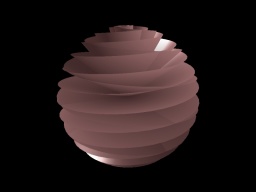
My main project for Evoke 2006 was »nano« (see below), but LinuxDemos.org announced a special Linux competition: The best-placed demos in the three PC categories (demo, 64k and 4k) would get an additional prize! I’m not into getting prizes, but it seemed like a good occasion to try some Linux democoding. However, there was not enough time for a demo or 64k (»nano« wasn’t in beta stage until the weekend before Evoke) so I did a 4k instead. It wasn’t a serious effort to do a great, well-designed intro – it was just a quick hack with one effect that came to my mind. Originally, it was called »Nameless Crap 2«, but Gabi came up with the very fitting »Moebius« name some hours before the compo.
The other PC 4k entries at Evoke were of excellent quality, so the 5th place was more than I deserved. Also, my entry was the only Linux one, so I got the LinuxDemos.org prize, too :)
Awards:
- 5th at Evoke 2006 PC 4k Intro competition
- 1st at Evoke 2006 / LinuxDemos.org Linux 4k Intro competition
Downloads/References:
- Moebius.tgz (9k) – the intro (Linux only!)
- get it at scene.org
- discussion at pouët.net
nano

Since I read the first reports on how to get iPodLinux working on the iPod nano, I was inclined write a demo on that neat device, or at least try to do so. The cool thing was that I never heard about demos on iPods except one, which ran on old black/white hard-disk iPods and was quite old-schoolish. So I was the first on the specific iPod nano platform, or even modern-age color iPods in general. But I didn’t want to do a mere »look, here we are« demo – I wanted something cool. Something with a concept and design, something comparable to today’s Amiga demos. The choice of the topic was quite easy: Lacking better ideas, I went for the straight-forward »nano« / sub-atomar theme.
Awards:
- 1st at Evoke 2006 Wild / Alternative Platforms competition
Downloads/References:
- nano.tgz (4.5M) – the demo, runs on iPod nano (first generation), Linux/x86, Windows, and the GP2X
- discussion at pouët.net (there are also some video links)
- article: Making Of »nano«
Origami 3.5k
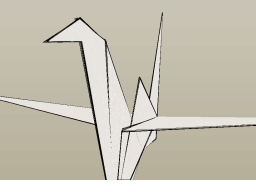
I had a really hard time with this one. After tUM, it was clear that I’m going to do a 4k intro, but originally, I had planned a completely other theme. But some fine day, Gabi came up with that really great Origami idea that stuck in my head. I was sure that it is possible in 4k, I just didn’t know how to represent all the geometry. But once I found out how to do it, everything went well … I frequently underbid my size estimates and ended up with 3.5k, with all relevant content. The not-so-nice thing was that only one week before Breakpoint, we suddenly discovered that there was already a Origami-themed demo – even worse, a 64k, 3rd at Assembly 2005! We didn’t know about that before, but we were quite sure that someone would remind this, and we would lose the uniqueness bonus we badly need, because honestly, we don’t cut it technology-wise :) But fortune was with us, and somehow we managed to win the competition, even with quite some distance to the second place …
Awards:
- 1st at Breakpoint 2006 PC 4k Intro competition
Downloads/References:
- origami.zip (5k) – the intro
- get it at scene.org
- discussion at pouët.net
rastro
Rastering, or prepress technology in general, is one of the topics of my personal interest. So nothing was more logical than combining that with the demoscene and produce an intro based on rastering effects. The concept seemed to be truly new, a quick search on pouët revealed no relevant hits. The intro was made in only 14 days of work – intense work, that is.
Awards:
- 1st at Evoke 2005 PC 64k Intro competition
Downloads/References:
- rastro.zip (48k) – the intro
- get it at scene.org
- discussion at pouët.net
vortex
Until 2005, I didn’t consider myself as a true, »worthy« demoscener. So I did a little 64k intro, containing a loose mix of random scenes that came to my mind, specifically for the Freestyle Dust 9 DCC only. The organizers seemed not to believe what they saw – they immediately talked me into submitting the intro (in a more polished version) at Breakpoint. And so I did. And for a one-man first-time intro, »vortex« did surprisingly well. I even felt sorry for bypass, because they had a really great 64k intro that got a totally undeserved 5th place behind me.
Awards:
- 1st at Freestyle Dust 9 Digital Creativity competition
- 4th at Breakpoint 2005 PC 64k Intro competition
Downloads/References:
- vortex.zip (61k) – the intro
- get it at scene.org
- discussion at pouët.net
nameless crap
In 2004, Freestyle Dust, a small local LAN party from sceners for gamers, did a »Digital Creativity Competition« (DCC) for the first time. As a junior coder with some amount of OpenGL knowledge (from the computer graphics course at university), I took some time to do a small intro without sound. Some of the scenes were even added at the partyplace, for example the city scene. I ended up with a 12k-sized intro, but I did some cheating: The >200k GLUT library is required to run the intro.
Awards:
- 2nd (? – not completely sure) at Freestyle Dust 8 Digital Creativity competition
Downloads/References:
- nc.zip (107k) – the intro, including the GLUT library
Games
Kakiarts 8-Ball
This game has actually been in the works since 2003: At that time, I had a university project involving a billiards table, and parallel to the project work, I wrote a simple yet complete billiards game at home. It was cross-platform, based on the GLUT library, without sound and buggy as hell when I stopped working on it in summer 2003.
Fast forward three years: Knowing that this project would make an ideal 32k or 96k game, I started porting it to Win32, adding sound and music and fixing the nasty gameplay bugs. At that point, I was at ~60k, which was enough space to integrate Gabi’s nice title screen, too.
The whole thing was ready to be released at tUM 06, but it was the only entry there, so we delayed the release until Breakpoint 2007.
Awards:
- 3rd at Breakpoint 2007 96k Game competition
Downloads/References:
BlockOut 8k / 6k
The Win32/OpenGL port of the good, old Amiga and PC game was actually in the works since after Breakpoint 2005. It was scheduled to be released at Evoke 2005, but some weeks before the party, I discovered that Evoke didn’t have a game compo. (Which was actually a good thing, because otherwise, I wouldn’t have started to do a 64k intro – the very 64k intro that won the compo at Evoke …) So the game had to wait some more months until tUM where it only got the second place (out of 2), perhaps because it lacked sound. The tUM party version was still 8k in size, using a 20to4 .cab-dropper for compression. Some weeks later, I used Microsoft C++ Express and Crinkler and shrinked it down to 6k without too much work.
Awards:
- 2nd at The Ultimate Meeting 2005 Game Development competition
Downloads/References:
- blockout.zip (23k) – party and final version binaries
- get it at scene.org (party version only)
- discussion at pouët.net
Graphics
Springtime
One week before easter 2007, I noticed that beautiful tree on my way to the supermarket. The day after, I took some pictures of it and found one particular picture so cool that I showed it to some friends, some of which suggested to submit it into the Photo competition at Breakpoint. I did so and got a decent place with it. End of story :)
Awards:
- 11th at Breakpoint 2007 Photo competition
Downloads/References:
- springtime.zip (4M) – high quality PNG, 1600×1200 JPEG, and the original photo
- get it at scene.org
Easter Chillout
Breakpoint 2006 was one of the first parties that had a photo competition, so that was the right place to do something I’ve already wanted to do long before: Create the illusion of a »transparent« picture or, in this case, notebook display. This really is a photo. I repeat it here because it’s often mistaken for a composite image, which it isn’t.
Awards:
- 5th at Breakpoint 2006 Photo competition
Downloads/References:
- easter.zip (1.2M) – .png version with readme text
- get it at scene.org
PS – PostShrink
TUM*05 offered something completely new: A vector graphics competition. This was a good occasion to do one of my especially weird hobbys, PostScript coding. The result was a PostScript-wrapping language called PrePost that takes some of the stack management chores off the coder. The entry itself is somewhere between a 4k intro and a real image: It’s a 4k PostScript file containing procedural 3D graphics. Unfortunately, the vector graphics compo had only two entries and thus got canceled. The entries got moved into the »modern tools graphics« competition, where they somewhat got lost between the other very good entries. (I would have had the other option of entering it as a 4k intro, but there I’d got lost, too, so there’s no difference.)
Awards:
- 6th at The Ultimate Meeting 2005 Modern Tools Graphics competition
Downloads/References:
- postshrink.zip (177k) – original file and development tools
- get it at scene.org
Pens
The topic for the Breakpoint 2005 theme graphics competition was »real vs. fake«. Originally, I didn’t have planned to do an entry for this, but some hours before the deadline I was considering to enter an old POVray image I’ve done a few months earlier. I didn’t want to release it as-is, because I already had the image on my old homepage and the compo rules forbid unchanged re-releases. Fortunately, I sat next to SubC, who came up with the idea to copy a real pen into the image. Well, I did so … and the rest is history …
Awards:
- 1st at Breakpoint 2005 Theme Graphics competition
Downloads/References:
Other Stuff
Discocubes
Four hours before the deadline, we decided to participate in the tUM 2006 »Disco-Style Effects Coding« fast competition. I took a scene from »vortex« as a basis and added some typical disco-style stuff: Some pointless animation, animated floor (thanks biff), glow (thanks SubC), overlay graphics (thanks faline) and of course disco-style music (thanks dq). I had some major problems with the schedule, but in the end, we needed to stretch the timeline by »only« half an hour. The effort paid off: We even beat Farbrausch’s entry and won the compo!
Awards:
- 1st at tUM 2006 Disco-Style Effects Coding compedition
Downloads/References:
- discocubes.zip (1.2M) – the executable demo
- get it at scene.org
- discussion at pouët.net
Blubb
Buenzli 2006 brought a new type of competition: 4k procedural graphics. The task is to write a (max.) 4k program on any platform that generates an as-nice-as-possible still image. A compo of this type was also held at tUM 2006, so this was my chance to have a try at this new type of contest. The entry is nothing special – essentially, it’s a by-product of an abandoned second iPod nano demo, ported to Win32, bugfixed and crammed into 1430 bytes (including a »save image to file« function).
Awards:
- 4th at tUM 2006 4k procedural graphics compedition
Downloads/References:
Think inside the box
This one is a typical party production. During a few boring moments at tUM 2007, an idea I originally had the year before re-occured to me: A view from inside a Menger sponge (also occasionally referred to as Cantor cube). In just a few hours, I devised an idea of how to draw such a thing with some primitive ambient occlusion lighting algorithm and got the second place in the 4k executable graphics compo with that. Little did I know that the exact same idea had already been implemented by somone else at Buenzli 2005. And even less did I know that half a year later, that effect was going to be done in realtime and much better quality by another group …
Awards:
- 2nd at tUM 2007 4k procedural graphics compedition
Downloads/References:
- kj_box.zip (444k) – the program and a PNG file of the output image
- get it at scene.org
- discussion at pouët.net

 Post Feed
Post Feed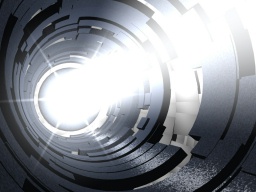

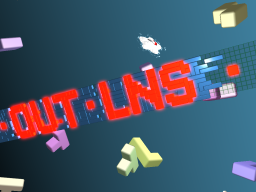
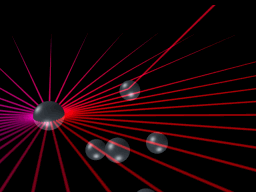
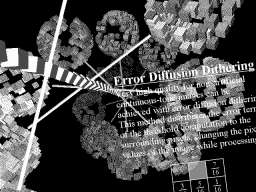

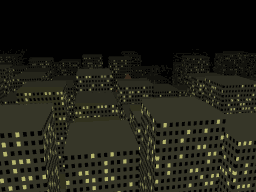
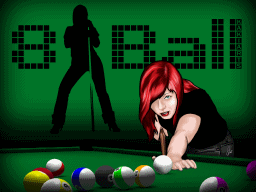



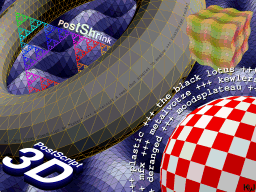

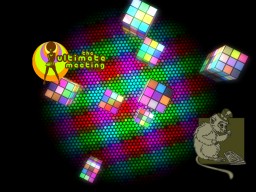
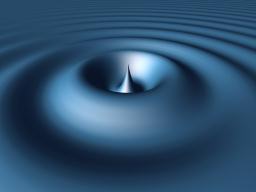
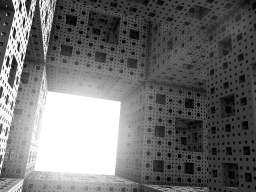
i wanted to congrate you, maybe a nit late for the 4 k you did , we really all loved it!!well done
i’m at a loss for words… and i’ve seen a preemptive multitasking OS run on a 4MHz 128KB calculator…
Nice PEN picture with the very best free raytracer.
I like it to do this think in source code only, but the workflow with tools like blender or KpovModler save some time.
Must go to browse the web for some povray macros :)
dexta
Nice report! Thanks!